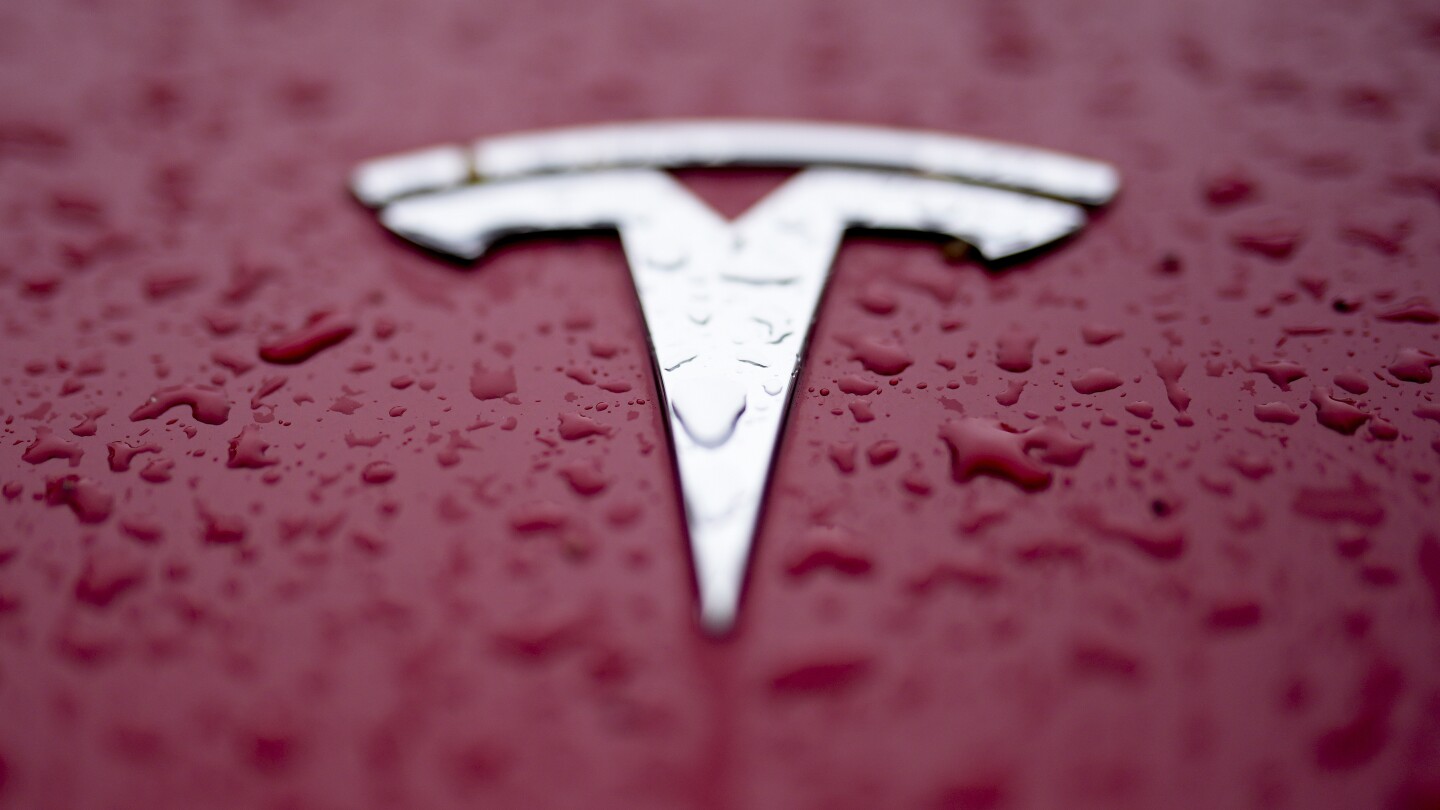California firefighters had to douse a flaming battery in a Tesla Semi with about 50,000 gallons (190,000 liters) of water to extinguish flames after a crash, the National Transportation Safety Board said Thursday.
In addition to the huge amount of water, firefighters used an aircraft to drop fire retardant on the “immediate area” of the electric truck as a precautionary measure, the agency said in a preliminary report.
Firefighters said previously that the battery reached temperatures of 1,000 degrees Fahrenheit (540 Celsius) while it was in flames.
The NTSB sent investigators to the Aug. 19 crash along Interstate 80 near Emigrant Gap, about 70 miles (113 kilometers) northeast of Sacramento. The agency said it would look into fire risks posed by the truck’s large lithium-ion battery.
Our town had to use an excavator and dozer to bury a Tesla car because it wouldn’t stop burning.
Our town…
Do you mean Babylon, Marduk?
😃
I don’t want to say the town’s name. I am a CERT member and that’s where I heard about it.
I read in a firefighter’s thread that the trick is to use a low pressure spray directly on the battery compartment. (It was a thread about Tesla cars not semis though so that might not apply)
The reason was you can’t actually put the fire out, it’s self oxidizing (it can literally burn underwater) so you basically need to wait till it burns itself out. Fortunately batteries only hold something like 1/10th the energy of gasoline and can’t release that energy as quickly so a fine light spray is enough to keep it from getting hot enough to catch anything else on fire including batteries in the surrounding battery modules.
Takes a long time, like hours to get it to a point they can move the vehicle and literally a couple weeks before the reaction completely fizzles out. They have special lots they tow them to where the car can fizzle itself out without damaging anything surrounding it.
Is water the best choice for a chemical fire?
Depends on the chemical, but it is an appropriate way to fight a liion battery fire though.
You’re fighting thermal runaway. Water is very effective at cooling and helps control the fire and keep the heat down. US DOT recommends water spray.
Maybe. Water is cheap, available in quantity, and non-polluting. Since a battery fire is self-oxygenating, I don’t think putting it out is something you expect. All you can do is take away the heat both to contain the damage and to eventually stop the reaction.
And water has great heat capacity, with a nice phase change, too.
From reading other links in this post, it sounds like pollution (runoff) is a concern, which is unfortunate.
The water is non-polluting, the battery chemicals not so much
I don’t think so, but what else are you gonna do? Can’t really submerge it in foam at a moments notice like you’re supposed to
The nords figured out you can put it out immersing it in salt water. Pretty self explanatory.
Toss them into the sea and never look back?
It absolutely isn’t.
But it the most available and least toxic fire suppression, especially on a highway.
Foam is full of PFAS, etc and the cost (in CO2 and money) of air dropping, and having to wash the foam off the highway afterwards - leading to runoff - is huge.
Imagine that happening 100 times per day on American highways (when electric trucks become commonly used).
This is a very confident statement. Surely you have the qualifications and certifications to back up your confidence?
How about a google search then you dunce:
“water should not be used on fires involving electrical equipment, grease, or certain types of chemicals.”
Mmhmm mmhmm. So by any chance do you know why it shouldn’t be used on those types of fires…?
Not my responsibility to educate those too stupid to Google stuff.
“I tried to act smart but I lack the supportive data and citations, so I’m just going to revert to the 8th grade with a good-ol’ no u and tell them to look it up themselves. I’m the smartest person in the room!” -you
Where did I try to act smart? What are you talking about?
Nnnno, I’m sorry, you’ve misunderstood - I was airing my (fairly reasonable) doubt that you don’t know why it shouldn’t be used on those types of fires.
It is, I admit, also not my responsibility to educate those too stupid to google stuff, but just for fun: Electrocution risk, grease fires explode when doused with water, unknown chemicals may interact with water unpredictably.
Water is absolutely used to combat battery fires. It won’t extinguish them, but since firefighting is more complicated than “it puts the water on the flames or else it gets the hose again”, that’s not really the goal. It’s to keep the chassis/batteries cool, douse the surrounding area to prevent the fire from spreading and keep any toxic combustion products from spreading via smoke (yes, that means they get washed into the environment. Not ideal, but better than breathing it.)
Water is in fact use, very often. I said it’s not “the best”. You yourself said it’s not ideal, completely agreeing with me.
Can you make clear your point other that picking fights on the Internet?
Maybe I’d even consider answering if you show my where I said that. And don’t count that quote of the first google response, that was just an example of how easy stuff is to look up.
How much is this in Capri Suns?
950,000 Capri Suns
(200ml per Capri sun, 5 Capri sun per litre, 190,000 litres water)
But it would take a long time to open each packet and spray it on the fire.
But it would take a long time to open each packet and spray it on the fire.
- Lay the Capri Suns in the ground next to the fire
- Get another semi truck
- Drive over the packets to squish out the liquid onto the fire
- If the additional semi truck catches fire as well, repeat from step 1
Fuck. Get this dude into Congress right now.
Do we have they did the math yet?
We need that Lemmy community!
just get as many of your friends to squirt capri sun with you
About 1/3 of the amount that will make a child say “please, mom, no more Capri Suns!”.
There’s 5 200ml Capri Suns to a liter. At about 190,000 liters, we’re looking at about 950,000 Capri Suns.
Somehow those packets seemed a lot smaller than 200ml.
I went through “Bedrijfshulpverlening” (Dutch, if you want to run it through translate just in case I mess up the correct translation). I guess it’s business first responder or something.
When we were attending the fire training part and we were teached about fires, someone asked “what if there is a car fire”. They said: “starting petrol car fires can be extinguished with a portable extinguisher if you are lucky. But electric car fires, leave them alone. They seal the cars in special water-filled containers and leave them alone for two weeks. There are reports that even after the two weeks, when the car was retrieved from the water, the fire started again on it’s own. Firefighters really hate electric vehicles”.
Lithium is a metal right? Putting water on a metal fire usually just makes the fire worse.
Lithium isn’t just a metal it’s a metal that has a rapid exothermic reaction with water. Or at least that’s what I remember my high school Chem teacher saying.
That’s when it’s not even on fire, right? Like pure sodium or aluminium (I forget which one combusts in water and which was just the air)?
Pure sodium can react with the moisture in the air. (If I recall correctly).
Aluminium is used in drink cans and is very inert. Aluminium shavings can burn though and they’re difficult to extinguish.
Pure elemental aluminum isn’t stable. The aluminum used in cans and such is an alloy and not pure elemental aluminum. My chemistry teacher blew a hole in the ceiling tiles of the classroom when he showed this off. The sodium didn’t react nearly as violently (but he also used a much smaller chunk).
Are you referring to the immediate oxidation of the outer layer when exposed to air?
aluminum is stable in the sense that the outer layer oxidizes rapidly and prevents the rest of the metal from reacting with anything. the reason thermite is so exothermic is because of massive amount of surface area provide by the powdered metal. a chunk of aluminum simply isn’t dangerous.
You are right, but in the case of a Lithium battery fire the strategy is to use the large thermal capacity of water to cool the battery until the reaction is done.
I just remembered i can even name myself as a source when i fucked up and punctured my phone battery while disassembling it (those dumbasses used large amounts of adhesives to mount the battery and i wasn’t careful enough). I simply dropped it into a bucket of water and waited it out.
business first responder
"alright, is everyone here? this is an all-hands meeting. Where is Joey? Is he in the bathroom again? He’s missed the last 3 meetings… Anyway. Top of the agenda, there’s apparently a fire, right over there. Fires are kinda hot and so we have been sure to stay a good distance away, as to not raise the temperature of everyone’s complimentary bottled water, handed out at this meeting.
Now it says here that we should tackle this situation as quickly as possible. Has anyone run the numbers by the finance team? We don’t want to spend too much on this. The big-wigs upstairs never think about the big picture, and really I don’t see why one fire is worth pivoting all our available resources. Samantha, yes?"
“Sir, the fire is growing at an alarming rate, shouldn’t we just postpone the meeting and focus on the fire?”
“See, that’s exactly the kind of thinking the execs have. But if we spend all our resources, cuts will be made, and jobs will be lost. Not mine, of course, but others. Did anyone do a PR analysis on us ‘putting out this fire’ versus just running a week-long ‘we are sorry’ ad campaign?”
(lol I just got the thought and ran with it)
“This could’ve been an email”
In Amsterdam firefighters have thrown burning teslas in de gracht for a few days.
How much water does it normally take to put out a semi fire? Say a tire fire, engine fire, or the entire contents of a semi in flames? I couldn’t find the answer googling, but I did find that combustion engine semis burn at the rate of 7000 per year.
https://plattner-verderame.com/blog/the-dangers-of-truck-fires/
I don’t even think this is the right metric to use.
You aren’t putting a lithium battery fire out with water. You’re just keeping it at bay until the energy is all used up. The more energy, the longer it’ll take.
We might need new ways to deal with these fires, but it’s not like we can completely submerge a semi in water.
I wonder how encasing the object in a fire retardant foam would behave, although we gotta think about the toxicity of that too.
Edit: I wonder if you could even calculate the amount of water you’d need to hold it off upfront based off the battery size and current charge.
There’s already tools to deal with lithium fires, class D fire extinguishers, sand and vermiculite. When I worked heavily with lithium non-rechargables we had lithium disaster plans for fires, explicitly in that was alerting fire fighters that it’s a combustible metal fire so they can react accordingly, those fires need to be smothered afaik, water was a big no no.
Generally though, the plan was, escape and enforce a quarantine zone because primary cells give off nasty stuff, if you can drop it in a bucket of vermiculite if it’s out of the containment vessels and pretty much let them do their thing. Then once it seems like it’s done, wait more time to make sure it’s actually safe with 30 minute gas tests, then package them for safe transport.
The problem though is how do you do that in the middle of nowhere on the highway like in this case? We need something big enough and portable enough. They clearly didn’t have that for this fire.
Totally fair, awareness is a big thing too, fire crews are professionals so I do think they made the best choice with what they were given, every firefighter I’ve met will absolutely do an assessment before doing anything.
Don’t know their situation, were they just told vehicle fire not lithium fire? Maybe more lithium specific crews/equipment in the future, maybe battery compartments that can help contain? (As I said, with lithium batteries I’ve worked with in the past, pressure vessels, if they went off it was at least contained to inside that, they’d vent gasses still but at least the threat of fire was minimised)
My bet is they were just told it was a fire, i doubt the person to drive by and report it would have known it was an electric truck.
The batteries definitely do have fire protections, to help delay the spread. Dousing it with 50k gals of water may have prevented the spread to another compartment for all we know. For something as big and higher risk like a semi though maybe there’s a way to eject compartments. Like if a fire starts in Module 1 of 4, modules 2 to 4 can eject themselves further away. Then were only dealing with a 250kwh fire instead of a 1mwh fire. It would add weight though.
Edit: And then while the firefighters keep the flames at bay, something could get attached to the other compartments and be dragged further away.
Firefighter here. Sometimes a better and less harmful option is to let things burn and protect the area. I went to a semi wreck that was hauling diesel and on fire on its side in the grassy median about 100’ away from a storm drain. Trying to put that out with just water would have become an environmental nightmare if all that fuel would have gotten washed into the storm system.
“But electric bad” is what this kind of news will make rednecks think, and they will over sentionalize the conflagration of an ev battery
My primary is a prius and I’ve done auto work and tech repairs for like 25 years now.
I’m not buying an all electric EV, yet. They’re still wasteful and heavy and the battery tech isn’t quite good enough. EV’s pretty much have a life of 15 years on them (after going through tires faster) and then off to the junkyard once the battery goes out. I have high hopes for the solid state batts from Samsung hitting some production EV’s in 2027, though. Lighter, faster to charge, and longer lifespans. Until that, I’m sticking to hybrids, where the battery is less than 100 pounds, cost a few grand instead of $15,000 and you can swap one out at home in an afternoon with no special/expensive equipment.
removedant?
lol
Probably only shows up that way on lemmy.ml, which has a blocker for various things they consider slurs, which can become silly when you’re dealing with words/phrase like “fire retardants.” Looks normal to me over on blahaj, and the same over on lemmy.world
Probably only shows up that way on lemmy.ml, which has a blocker for various things they consider slurs
Lmao, the community most likely to complain about censorship…is practicing… censorship lolol
It’s the Scunthorpe Problem.
The Sremovedhorpe problem, you say?
lol surprisingly cunt isn’t blocked on lemmy.ml
That’s quite the biased word blocking list :/
Thanks for that. I was unaware that is how it worked.
Remember that non electric cars are still dangerous too. Just think about how often you see a wreck that has cops, firetrucks, and cops all around it. That isn’t going to make the same level of national attention as an electric car burning would get.
There are a lot of reasons WHY news agencies disproportunatly show the downsides of green energy, and I’m hardly scratching the surface, but here’s my personal reasoning:
News sites like to over dramatize green energy dangers as they are funded by fossil fuel companies (ads). Theres a large amount of disinformation that they misleadingly tell people, take for example birds running Into windmills is something a LARGE amount of people know and think is an issue. However, statistically fossil fuels cause ~50x (iirc) more bird deaths per unit of energy than windmills due to birds being an apex preditor. Another example is that nuclear waste is a big issue that will prevent nuclear energy from becoming superior when that issue was solved several decades ago.Yes, elon sucks and some of his practices should be banned, but it’s still green energy and you can’t let it distract you from the benefits of all electric vehicles.
There are a lot of reasons WHY news agencies disproportunatly show the downsides of green energy
Electric cars are not “green energy” - that’s utter bullshit.
-
the energy consumption of electric cars is about as clean as the power plant that produced said energy - if that happens to be a fossil fuel plant, it’s dirty as fuck, just with the pollution in a different location from where the car is driving If you have renewable energy, then yes, they can be cleaner, but:
-
we don’t have enough (mineable) rare earths to replace even a sizeable fraction of the world’s car market with electric vehicles
- A great deal of electricity is produced by renewables these days, and that percentage increases every day.
https://www.eia.gov/todayinenergy/detail.php?id=48896
https://ec.europa.eu/eurostat/web/products-eurostat-news/w/ddn-20240221-1
- There’s plenty of lithium. Lithium batteries are also recyclable, unlike fossil fuels.
https://www.sustainabilitybynumbers.com/p/lithium-electric-vehicles
- Sodium ion batteries are also a thing.
As I was saying in my first comment: If energy is produced by renewable sources, then they can be clean, so there’s no argument here.
Re:
https://www.sustainabilitybynumbers.com/p/lithium-electric-vehicles
- the article focuses on lithium, which is not the only problematic material used in electric batteries
- the first source I checked (on total lithium in the world) was offline, so I could not confirm my suspicion that the author was talking about the total amounts including those inaccessible in the Earth’s mantle
- the author admits herself that we have “enough lithium for decades to come”, which is in-fucking-credibly stupid, because this planet has been around for billions of years, and one of the biggest flaws of mankind has been to empty a natural resource over a few decades “coz profits”. Creating a demand for a resource that would only make it last a few decades would create another clusterfuck like all the wars and blood shed over crude oil. As a matter of fact, for mining conditions, we already have this clusterfuck, if you look at e.g. how cobalt is mined in the “democratic” republic of Congo
Finally, like I asked another commenter: could you provide a source on EV batteries made without rare earths?
By the way - sodium requires salt, and that’s also limited on Earth. Knowing mankind, we’d extract locally (desalinification hurts the ecosystem there) and dump waste locally in another location (again, hurting the ecosystem).
My overall point is: the world’s car market is just too big and we need to shrink it, but mankind as a whole is too fucking selfish and stupid and short-sighted to accomplish that, and I WISH time will prove me wrong on that.
People also dont get the differece between average and marginal. Adding consumption doesn’t build more wind farms. Adding extra electricity consumption means in short run burning more coal and gas. They are the ones that can be ramped up / ran more hours.
In the long run they might build more nuclear, but that takes a (very) long time. Generally they’re building solar and wind pretty fast already, it is hard (costly) to ramp that up.
Adding new sources of electricity consumption just keeps the fossil fuel power stations running for longer. Efficiiency is stuff like electric mass transit to replace as many car trips as possible - and using as much wires as possible instead of batteries. But no all the money will go into facilities and subsidy for battery powered cars.
Adding extra electricity consumption means in short run burning more coal and gas. They are the ones that can be ramped up / ran more hours.
I think that’s only gas plants, that can react dynamically to changes in the grid?
I think what we need is consumer electronics that can tolerate more variation in the grid power supply - e.g. a laundry machine that runs on 80% voltage just as well, but then takes a bit longer to finish.
Nuclear power plants are only preferable to burning fossil fuels, and only when run by responsible entities (i.e. not by humans ;) - definitely not by profit-oriented corps) - I hope we can transition to enough wind, water & solar power, but we definitely need to cut down on energy consumption.
The dirtiest, least efficient coal power plant is still IMMENSELY more efficient than a car combustion engine. When you don’t have to make your energy generating device mobile, you can get a LOT more power from your fuel.
Maybe spend some time learning about a subject before you make claims about it. There’s less chance of looking like an ignorant fool that way.
Let me guess. You spend a lot of time in /c/fuckcars and therefore find ANY type of car bad and pointless?
First things first: Yours is a straw-man argument. I said that electric cars are not “green energy” because it matters how the energy is produced. You, however, argue for the better efficieny vs. combustion engines. I did not even MENTION combustion engines. So watch your tone, dumbass :p /s
Regarding your straw-man, I’ll bite:
Efficiency of an electric car is up to 65% including losses when charging. Efficiency of a Diesel powered car is up to 45%. Producing a liter of diesel costs about 1.13 times as much energy as is contained in a liter of Diesel fuel, which - even assuming 100% efficiency on winning that energy - is further bringing down the efficiency to 45% * (1 / 2.13 ) = 21% (one unit gained per 2.13 units invested). A coal power plant is at best reaching 45% energy efficiency, bringing the overall efficiency of an electric car down to 65% * 45% = 29.3%. That makes an electric car operating on coal generated electricity about 29.3% / 21% = 1.395 or about 40% more efficient than a Diesel powered car.
And this does NOT include that electrical vehicles are - due to the weight of batteries - around 50% heavier than combustion engine cars, and that battery life is much shorter and then generates a lot of electronic waste.
Accordingly:
The dirtiest, least efficient coal power plant is still IMMENSELY more efficient than a car combustion engine
Not true. Numbers for the most efficient coal power plants are just about equal with the efficiency of the best Diesel engines. But even moderate Diesel engines stay around 40% efficiency, whereas coal plants can be in the 30%-40% range easily.
When you don’t have to make your energy generating device mobile, you can get a LOT more power from your fuel.
- generally, larger generator = better efficiency, yes, however:
- see above: this does not necessarily hold true when the batteries increase the total weight of your car by 50%
While - all things considered (I honestly did not expect the production of Diesel to be quite so energy-inefficient) - electric cars fare better if driven at constant speed (or with good energy recuperation mechanisms on braking) and not taking into account the battery life, energy investment into that and chemical waste produced on production / disposal, they are far from getting “a LOT more power” from an “IMMENSELY more efficient” power plant.
Maybe spend some time learning about a subject before you make claims about it. There’s less chance of looking like an ignorant fool that way.
Likewise.
Not this nonsense again. 60% of EV owners have solar panels for starters
Secondly, they’re becoming increasingly less reliant on rare earth metals and all that can be recycled anyway
Their battery can be used for v2g to assist solar and further transition
Finally, they’re incredibly effectively compared to combustion.
In comparison to combustion and hybrid, they’re way cleaner over the entire life
And now with sodium batteries coming into the market, they’ll increasingly become so.
Are they as clean as bikes? No
But not everyone wants to be isolated within 5km of public transport and their home.
I’d have to travel 2 hours by train to get to work, and wouldn’t be able to go mountaineering or hiking anymore
Also, what’s with the nonsense about there aren’t enough mineral resources.
EVs don’t need to use lithium batteries. The technology can evolve with any battery chemistry or power source.
Whereas gas or hydrogen is limited to those two options permanently
Hydrogen in particular has absolutely s*** efficiency in all parts of the process. It’s only clean if you ignore the high energy wastage
-
Solar panels need to run for a couple of years before they produce net energy considering the energy invested into production
-
Source on battery production being less reliant on rare earths?
-
Speak English, please - I am not looking up abbreviations to argue with you
-
See my other reply here: https://lemmy.world/comment/12349903 Efficiency of an electrical car is better, but absolutely not “incredibly” better, as per the numbers I checked while writing that comment
-
How much cleaner EVs are, depends on the source of energy mix (which at charging stations outside your home, you can hardly control) - if renewable energies are used, they are certainly cleaner. If fossil fuels are used, they are at best (not counting the waste from battery production and disposal) as much cleaner as the efficiency improvement (which is about 40% over Diesel engines, by what I calculated from sources that were acceptably credible for writing an internet comment as opposed to a scientific paper)
-
I was not speaking about “mineral” resources, I was speaking about mineable rare earths. Because there are plenty in the Earth’s mantle, but we can’t get to those.
-
Again, source please on how EVs do not need rare earths for batteries
-
Agreed for the time being, but if research allows to improve the process for generation of hydrogen, it could be a cleaner combustion fuel
In summary: I am not arguing for combustion cars, I am arguing against EVs not for individual use cases, but as a “this solves all problems with combustion engines” - because it is not a solution applicable to the world market for personal mobility.
The best solution is a proper public transportation system - good bus connections and trains that can operate “by wire” without the need for batteries.
-
-
Maybe don’t use water to put out a fire that can’t be put out with water. Aren’t these supposed to be professionals?
The purpose of the water is to cool the wreck and the area around it while the metal fire burns itself out, because waiting it out is the safest option for the firefighters.
Flooding the batteries with water is the best way to put out a lithium-ion battery fire.
Isn’t oxygen deprivation (usually through burying) a much faster method?
Maybe for smaller things, a regular car maybe.
But by the time a suitable digging machine arrives on scene and digs a big enough hole for a semi it’d probably be faster to flood it with water. Not to mention what might be underneath the ground, so they’d also have to spend time determining if there’s any gas lines or whatever before they dig so they don’t make a much bigger problem
Lithium fires are self-oxidizing, so that won’t work. Burying it helps keep it from spreading, though.
Do you volunteer your backyard for such burials?
Sure.
Sure you would, now. It’s easy to be virtuous when the only things at stake are fake internet points.
I’d love to see you show the same heroism when an excavator in fire department livery comes to your house, rips up your front lawn, damages your water line and underground cables, potentially damages your basement’s walls, and carries off two cubic metres of soil to put out somebody else’s vehicle fire somewhat faster than water would. I’m sure you’d feel great about the damage you’d have to get fixed, even if you ignore the cost. Or do you think that fire departments would just buy dumptrucks to haul soil to fires on the off chance that the reporter correctly identifies the involved vehicle as having a lithium battery?
It’s not ideal, but water with fire retardant is the most practical solution.
It isn’t.
https://youtu.be/qgP7KkDesBo?si=XNb_yZYwA943t0lP
Water seems to put it out for a bit, but the reaction is self-oxidizing and starts right back up again. That’s why it takes so much water; fire fighters keep dowsing it and then doing it again. Takes all day, and the whole thing burns away in the end.
The way to do it is, if possible, tow it somewhere away from other things, keep the fire from spreading, and otherwise let it burn. For cars, there are fireproof blankets coming on the market to contain it. Semi-trucks are probably too big for that, though.
Well, the [vehicle] has been towed outside the environment.
For as much as people want their Musky circlejerks. This is really just a problem with the switch the EVs that people aren’t willing to accept.
There is no way to really stop an EV battery fire.
The batteries in these cars are made up of several cells, packed into a watertight, fire resistant box. When just one of those cells goes it’s over. It can create a chemical reaction that can ignite the cells without the need for oxygen, pure heat will set them off.
The only real way of dealing with them is to let them burn themselves out, and even after that they aren’t safe and could reignite.
The way to stop them is solid state batteries
Or maybe just good guys with Li-ion batteries.
What we really need is POCKET SAND!
And absolutely HUGE pockets!
It’s not the electrolyte that’s the issue, it’s the lithium. Solid electrolyte batteries wont make any difference. Unless by solid state you mean, no chemical reaction and we just switch to electrostatic cells, but that is nowhere near viable.
I had been told that solid state batteries are far more stable and less likely to have thermal runaway. Is that just bullshit?
It’s less likely, but if they do get lit on fire then you still have a class D fire on your hands. Unfortunately with car accidents and that much energy being stored in one place, fires are going to happen.
Supposedly there are non lithium solid state batteries, but I’m not aware of any commonly available for EVs
that sounds great, where can I buy one?
Let me know if you find out
honestly, i don’t expect an answer. New battery tech gets announced every year, claiming to revilutionize energy storage. None have made it to market in any meaningful way, if at all. Lithium batteries hit the sweet spot of price to performance, and nothing else can compete. Looking forward to the day that changes.
Massive changes have been happening in the battery field for decades, they just aren’t fast. Our rechargeable batteries are smaller, more energy-dense, longer-lasting, and cheaper than they were 40 years ago. They aren’t magical, last forever, infinite power, instant recharge batteries, though, that’s correct.
So, you actually can buy solid state batteries now at least as external battery packs to charge phones and whatnot, but they’re still lithium based,
You’ll take my spinning platter batteries from my cold, dead hands
How many lithium ion battery fires have you put out?
Two.
The best policy is to not puncture batteries, and train others to not do so.
The next best is to know to smother them.
how do you smother a semi fire on the highway, a) with a water tanker or b) with a sand tanker, how many municipalities have a sand tanker on hand, how do those sand tanker hoses work again, lots of sand tanker slingers round your parts cowpoke?
Isn’t that foam what we are discovered is leeching into ground-water supplies everywhere and is super unhealthy for everyone?
Foam suppressant is appropriate for liquid fuel fires like oil. It is not appropriate for metal fires.
You sure?
https://textechindustries.com/blog/how-do-you-extinguish-a-lithium-battery-fire/
To put out large lithium-ion battery fires, use a foam extinguisher containing CO2, powder graphite, ABC dry chemical, or sodium carbonate.
Not who you responded to, but that’s an interesting source. I’m intrigued by a textile company claiming to be experts in lithium ion fires.
It sounds more like options for preventing a fire to spread. It’s also including CO2 extinguishers under “foam” which they very much aren’t, making me doubt the rest of their blog post.
Extinguishing fires can work largely in two different ways. Either by smothering a fire or by cooling a fuel below it’s flash point. Quite often they put out a fire by doing both. A fire that contains an oxidizer cannot be smothered, but smothering can help prevent other materials in a vehicle from being able to burn along with the batteries. Cooling down a large, vehicle sized lithium ion fires takes an incredible amount of water. However, the cells themselves contain so much energy that their failure produces more thermal energy than water is able to remove.
Is water the best to put out large EV fires? Nope.
Is water good at preventing fires from spreading? Yep.
Is water easily accessible and carried on every fire truck and engine and available through hydrants? Also yep.
A lot of agencies are including car sized fire blankets as well that help smother the fire some and make burnt/burning EVs safer for tow trucks to move to a safe locations where they can be left to burn out. Sometimes for over a month! You might see fire engines literally escorting tow trucks because even with the blanket and being doused with tens of thousands of gallons, it’s still at risk of reigniting during transport.
The other big issue that agencies are facing with EV fires is that the water used to suppress these fires essentially becomes hazmat. So there are issues with letting it just run off into the storm system or the environment.
a foam extinguisher containing CO2, powder graphite, ABC dry chemical, or sodium carbonate
Huh? modern foam suppressants do not use dry chemicals or powders (https://en.wikipedia.org/wiki/Firefighting_foam).
The Wikipedia article has this:
The original foam was a mixture of two powders and water produced in a foam generator. It was called chemical foam because of the chemical action to create it. In general, the powders used were sodium bicarbonate and aluminium sulfate, with small amounts of saponin or liquorice added to stabilise the bubbles. […] Chemical foam is a stable solution of small bubbles containing carbon dioxide with lower density than oil or water, and exhibits persistence for covering flat surfaces.
Which sounds like what your article is talking about, but nobody uses that anymore, it’s from 1904:
Chemical foam is considered obsolete today because of the many containers of powder required, even for small fires.
Was this article written by an LLM copying text from other sources? It’s basically just an ad for this company’s products. I wouldn’t trust this source for real-world firefighting information.
Anyone dealing with batteries would have. It is more common than you think and not just people being keyboard warriors.
AFAB?
No.
all fires are bad…?
Is this 190 tons of water?
189.27 metric tons of water, so yes, rounded up, 190 tons.
Or roughly 2.5 average swimming pools and for those ex-redditors out there: 1.6 million bananas
Something tells me that we have to move away from cobalt/manganese chemistries for BEVs.
Solid state batteries are supposedly much more fire resistant.
Even the currently available LFP is much less violent.
Yes, true. Albeit they have worse energy density and some advantages as well.
How are you getting 189.27? 1 liter is 1kg, so it should be 190 precisely.
Because we are discussing metric tons of water where 264.17 US gallons = 1 metric ton of fresh water @ 4’C
Hmm… I’m gonna guess that water was much hotter than 4°C, what with being used to put out a fire and all.
What size is an average swimming pool area-wise? Or are you talking about Olympic size swimming pools?
Feet: 16’ x 32’ w/ a 4’ shallow end and an 8’ deep end filled with fresh water at an exact temperature of 39.2’F.
Metric: 4.9m x 9.7m w/ a 1.2m shallow end and a 2.4m deep end filled with fresh water at an exact temperature of 4’C.
How many washing machines
See, that’s why I’m so glad they cleared a whole forest in a water protection area to build their german gigafactory.
Water and trees are totally overrated.
s/
deleted by creator
They have “Tesla Semis”?
Yep, the Tesla Semi has been in limited production, and in use as a hauler. It’s got up to a 500 mile range on its massive battery bank (with real world loads clocking at least 375) and it way outperforms diesel in the performance category.
Of course, you still have to charge it, so that bit has to be sorted out first before long haul is viable with these.
Yeah, some of them even work and are good enough to haul chips.
I wonder, would some quickly deployable heat barrier to surround it that can be filled with water once work? Kind of like dunking it a pool, except kind of backwards in that the “pool” is deployed around it and then filled?
I’m not sure how you just build a pool that doesn’t leak and can hold the weight of the water…
You couldn’t build it and get it filled fast enough. Also with a 1k degree battery a lot of that water is boiling off instantly.
Hmm, yeah, good point. What if you throw a bunch of dirt or sand on it from a truck filled with it from a distance until it’s covered? Like one of those things that poke up from wood chippers and launches the chipped wood into a higher truck, but redesigned to throw dirt or sand at a burning EV from a dump truck at a safe distance?
Surely firefighters know better than to use water on a battery?
Currently, water is still the best option, when you have access to enough of it.
But I’m sure they’re all ears for your better solutions.I don’t understand. Water is mentioned as a valid extinguishing means in the paper you linked, what’s your argument?
Where does it say to use 50,000 gallons of it?
Sorry but that link is just general guidance (it mentions sprinkler systems) and doesn’t apply to outdoor environments, where groundwater contamination is an issue, and especially highways, where any extinguishing infrastructure must be mobile and quick cleanup is a major priority, very well.
If 50,000 gallons of water is the best and most effective and safest option to douse a battery fire, and that’s what firefighters did, then why is anyone complaining about it?
Cause it just sounds like a lot.





















